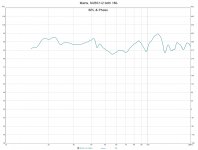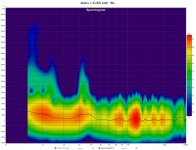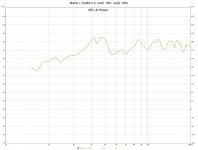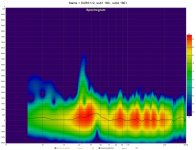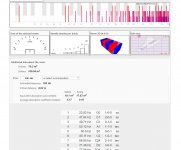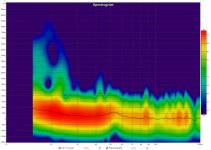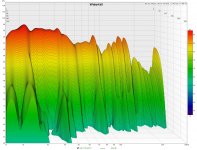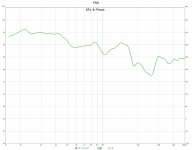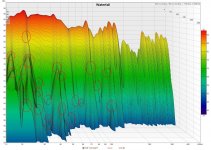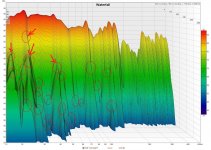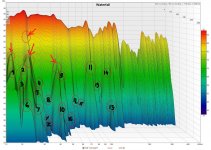The second plot proves my claim incontrovertible. The holes (or zero in math jargon) at 18, 21 and 25 Hz can only be the result of a secondary source interfering with the primary one. But those aren't important so no reason to worry about them. To me the issue at 100 Hz is more important. That was evident in the mains as well. SOmething bad is going on their. I am shocked that only one resonance at 46 Hz is evident. This is highly unusual at LFs in small rooms. This implies very large amounts of damping. Does not look like concrete, unless the room is so small that this is the lowest resonance. The rest of the plots don't mean much to me. Especially T60 - at LFs? Violates the fundamental assumptions of T60 as a statistical quantity.
18, 21 and 25 Hz? You mean those blue dots? Interesting, yes.
The room has 1099589.99 sq ft, I don't know if that qualifies as small. Here are mode calculation results and 45 Hz mode is probably evident from the measurements.
Can a mode cause ringing?
Back to the subs: i tried different placement yesterday (with only two subs in the corners - each facing the opposite wall). Set both to 180- and here are some plots.
I then switched the polarity on the right one (to 180+). FR does not look as good but the spectrogram is better and so is the sound. A proof that nicer curve does not necessarily mean better sound.
What surprised me that playing both subs (without mains) on 180- produced a good bas. Adding the mains slightly ruined it but switching the polarity to 180+ improved it again.
Now I see ehat you were once talking about - how flipping the polarity/phase may turn everything upside down?
Since I have a lack of SPL below 30 Hz area I might put two more subs in the same place I had last week. Next to the speakers. I'm curious how it would sound. Probably I will be first one in history to have 4 subs in the front? 😉
The room has 1099589.99 sq ft, I don't know if that qualifies as small. Here are mode calculation results and 45 Hz mode is probably evident from the measurements.
Can a mode cause ringing?
Back to the subs: i tried different placement yesterday (with only two subs in the corners - each facing the opposite wall). Set both to 180- and here are some plots.
I then switched the polarity on the right one (to 180+). FR does not look as good but the spectrogram is better and so is the sound. A proof that nicer curve does not necessarily mean better sound.
What surprised me that playing both subs (without mains) on 180- produced a good bas. Adding the mains slightly ruined it but switching the polarity to 180+ improved it again.
Now I see ehat you were once talking about - how flipping the polarity/phase may turn everything upside down?
Since I have a lack of SPL below 30 Hz area I might put two more subs in the same place I had last week. Next to the speakers. I'm curious how it would sound. Probably I will be first one in history to have 4 subs in the front? 😉
Attachments
Yes, modes ring, directly proportional to their Q.
Normally one would expect the modes to ring out almost identical (small variations) - like the 41 Hz one is classic. But from the data, the lowest mode has to be coupled to somewhere else. As I said, it's probably a good thing. In my room my lowest mode is downright untamable, but at 20 Hz it's not much of a problem audibly.
Normally one would expect the modes to ring out almost identical (small variations) - like the 41 Hz one is classic. But from the data, the lowest mode has to be coupled to somewhere else. As I said, it's probably a good thing. In my room my lowest mode is downright untamable, but at 20 Hz it's not much of a problem audibly.
Last edited:
So that's a clear evidence, 45 Hz mode is ringing and so is the 23 Hz which you think it's coming from elsewhere?
I said "coupling to somewhere else" not "coming from somewhere else. This is a big difference.
The 45 Hz peak and ringing are normal and expected. The 21 Hz "resonance" in the chart does not seem to ring out normally and appears to have energy coming from "somewhere else" interfering with the main sound.
Hm, I'm asking because the 45 Hz ringing did come from a resonating device. Some time ago I was testing some Helmholtz resonators. They didn't do much, lowered the 45 Hz dip for 2-3dB. Turned out they caused ringing as well. Can't say sound changed much but I'm still happy for this. They got my curiosity because of your "coupling" suggestion.
Some say that ringing below 30 Hz isn't critical. You think it can still interefere with higher tones?
Some say that ringing below 30 Hz isn't critical. You think it can still interefere with higher tones?
OK, thank you.
I have another question. 😉
When doing experiments with settings one can get a pretty good FR (and spectrogram too!). But music is played something isn't right. It gets better if polarity is changed - but FR gets worse. I assume this has something to do with bass being of out phase?
I have another question. 😉
When doing experiments with settings one can get a pretty good FR (and spectrogram too!). But music is played something isn't right. It gets better if polarity is changed - but FR gets worse. I assume this has something to do with bass being of out phase?
Okay, finally an improvement.
This time I actually like the sound. It still needs work but I could live with this as well. I was aiming for a slight boost below 60 Hz so it's there on purpose. EQ wasn't used yet.
It's really a pain, all these settings, slopes, filters, gain ... Really took a lot of time and effort. And nerves. 😉
Turned out 4 subs are a must in this strange room of mine.
Now I'd like to take a closer look at spectrogram. Interestingly, I had better ones and didn't liked the sound.
What do you guys think?
This time I actually like the sound. It still needs work but I could live with this as well. I was aiming for a slight boost below 60 Hz so it's there on purpose. EQ wasn't used yet.
It's really a pain, all these settings, slopes, filters, gain ... Really took a lot of time and effort. And nerves. 😉
Turned out 4 subs are a must in this strange room of mine.
Now I'd like to take a closer look at spectrogram. Interestingly, I had better ones and didn't liked the sound.
What do you guys think?
Attachments
Your waterfall is difficult to interpret given that your window is so small. Try 450ms or 500 msec. Try a vertical range of 40dB.
Your spectrogram looks better at 45Hz. Less ringing. Lots of ringing below at 20-30Hz but that’s expected in small room acoustics and difficult to treat with room treatments. Moreover, the area from 40Hz and above is more audible.
At the end, it seems you have a target curve in the FR that you like...
Best,
Anand.
Your spectrogram looks better at 45Hz. Less ringing. Lots of ringing below at 20-30Hz but that’s expected in small room acoustics and difficult to treat with room treatments. Moreover, the area from 40Hz and above is more audible.
At the end, it seems you have a target curve in the FR that you like...
Best,
Anand.
Ah, yes, sorry.
Here.
I'm not done yet with the treatment and fine tuning but thing are finally moving in the right direction.
I'd like to avoid PEQ if possible. Somehow I think I like the sound better without it.
I shall try to tame this 87 Hz dip and see what happens.
Does Spectrogram look less equal because of the boost at lower area?
Here.
I'm not done yet with the treatment and fine tuning but thing are finally moving in the right direction.
I'd like to avoid PEQ if possible. Somehow I think I like the sound better without it.
I shall try to tame this 87 Hz dip and see what happens.
Does Spectrogram look less equal because of the boost at lower area?
Attachments
Last edited:
I think that with no EQ it looks pretty good. EQ would make it better and I don;t understand why you would not use it.
I still see energy coming in from somewhere else. You can see a rise in the decay at many of the resonances at the same time. No big deal, just interesting. Decay should be monotonic, any rise means energy from somewhere else - it's not ringing.
I still see energy coming in from somewhere else. You can see a rise in the decay at many of the resonances at the same time. No big deal, just interesting. Decay should be monotonic, any rise means energy from somewhere else - it's not ringing.
Oh, I'm not against it. It's just I did some quick tests and I didn't like the results. I should do more thorough tests and see.
I also figured out I wasn't looking the spectrograms with the same scale; hence the differences when low end was raised up. One learns every day. ;-)
I still don't see where you see many resonances at the same time? We are still looking at 23 and 45 Hz?
Thank you all for very educational debate!
I also figured out I wasn't looking the spectrograms with the same scale; hence the differences when low end was raised up. One learns every day. ;-)
I still don't see where you see many resonances at the same time? We are still looking at 23 and 45 Hz?
Thank you all for very educational debate!
- Home
- Loudspeakers
- Subwoofers
- Multiple Small Subs - Geddes Approach
